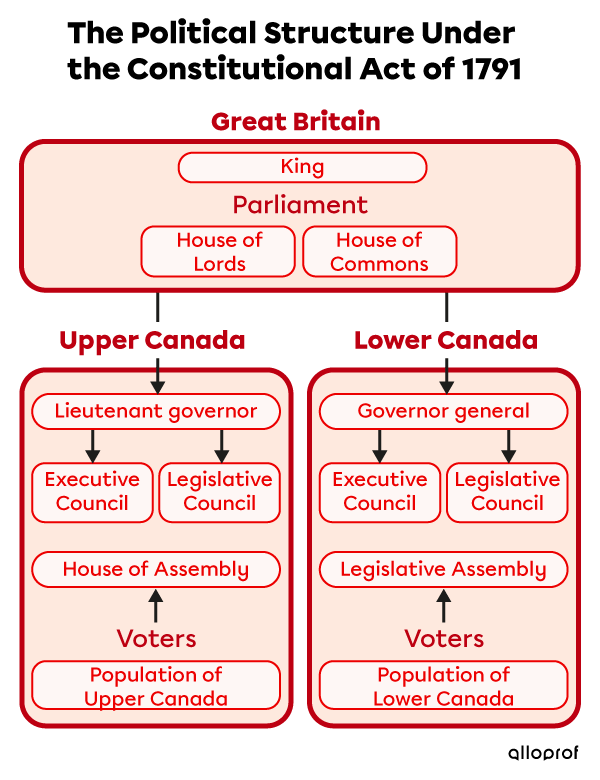Pressure and petitions from British merchants spurred the British Crown to introduce the Constitutional Act and establish new institutions to shape the political life of the colony. These new institutions supported liberalism, an ideology that promotes the right of individuals to govern themselves.
Both Upper and Lower Canada had their own government but shared the same political structure. Liberal values expanded with the arrival of the Loyalists. These values defended the principles of liberalism despite their loyalty to the king.
In politics, liberal ideas were expressed through parliamentary democracy, because the people chose their own government. Parliamentary democracy was essential to Loyalists because it provided the people with a representative government, meaning a government that truly represents the voters. Eventually, a representative government elected by the people would become a responsible government.
The Constitutional Act of 1791 established a representative political regime, but not a responsible one. To clarify, it was representative, because elections were held so people could choose the members of the Legislative Assembly. However, it was not responsible, because the governor had the power to make decisions that went against the views of the majority of the members elected by the people, and there was nothing they could do about it. Since the governor had the final say, the Legislative Assembly could not be considered responsible.
A responsible government is a government whose ministers in the executive branch are chosen from the elected members of the Legislative Assembly. The government must have the Assembly’s trust or it must be replaced. The terms “responsible government” and “ministerial responsibility” mean the same thing.

The governor general represented the king and the British Parliament in Great Britain and was the highest authority in the British North American colonies, among others, such as Lower Canada, Upper Canada, Nova Scotia and Cape Breton. Since governing so many colonies was a major task, a lieutenant governor was appointed in each colony as the governor general’s representative. Lower Canada was the only exception. Since the governor general lived in Quebec City, he took on the duties that would have been reserved for a lieutenant governor.
In addition to handling the defence of the colonies and their foreign relations, the governor general had the final say on all decisions made by the councils and the Assembly. This power, called the right of veto, gave the governor general the right to reject any law passed, even if it had been approved by the Legislative Council. The governor general also had the power to dissolve the Legislative Assembly, by removing the elected members from office and calling new elections. In addition, the governor general appointed the members of the Legislative Council and Executive Council.
The governors were not accountable for how they treated the people they governed; they were only accountable to the king and the British Parliament.
A Legislative Assembly was established in both Canadas, marking the beginning of democracy in these territories. Elections followed, allowing the residents of the colonies to vote for the representatives of their choice. The representatives who received the most votes became elected members, who represented the population by proposing and debating various bills. Once a bill was passed, it was submitted to the Legislative Council for review.
The Legislative Council of Lower Canada included at least 15 members. They were appointed for life by the governor and reviewed decisions made by the Legislative Assembly. The Legislative Council could also propose its own bills to the governor without being accountable to the Legislative Assembly.
The Constitutional Act also established an Executive Council. The Executive Council had at least nine members, also appointed for life by the governor, and its mandate was to enforce the laws passed by the Legislative Council.
This political structure favoured appointed members, while elected members had no real power. Unlike the members of the Legislative Assembly, members of the Legislative Council and Executive Council were appointed by the governor and not elected by the people. This allowed the king to maintain control over political decisions in Upper and Lower Canada, while also catering to lobby groups that demanded the establishment of a Legislative Assembly.